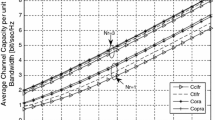Abstract
Space–time coding can achieve transmit diversity and power gain over spatially uncoded systems without sacrificing bandwidth. There are various approaches in coding structures, including space–time block codes. A class of space–time block codes namely quasi-orthogonal space–time block codes can achieve the full rate, but the conventional decoders of these codes experience interference terms resulting from neighboring signals during signal detection. The presence of the interference terms causes an increase in the decoder complexity and a decrease in the performance gain. In this article, we propose a modification to the conventional coding/decoding scheme that will improve performance, reduce decoding complexity, and improve robustness against channel estimation errors as well.
Similar content being viewed by others
References
Alamouti S. (1998) A simple transmit diversity technique for wireless communications. IEEE Journal on Selected Areas in Communications 16(8): 1451–1458
Foschini G., Gans M. (1998) On limits of wireless communications in a fading environment when using multiple antennas. Wireless Personal Communications 6(3): 311–335
Papadias, C., & Foschini, G. (2001). A space–time coding approach for systems employing four transmit antennas. In IEEE international conference on acoustics, speech, and signal processing (ICASSP) (Vol. 4, pp. 2481–2484).
Ganesan G., Stoica P. (2001) Space–time block codes: A maximum snr approach. IEEE Transactions on Information Theory 47(4): 1650–1656
Tarokh V., Seshadri N., Calderbank A. (1998) Space–time codes for high data rate wireless communication: Performance criterion and code construction. IEEE Transactions on Information Theory 44(2): 744–765
Tarokh V., Jafarkhani H., Calderbank A. (1999) Space–time block codes from orthogonal designs. IEEE Transactions on Information Theory 45(5): 1456–1467
Tarokh V., Jafarkhani H., Calderbank A. (1999) Space–time block coding for wireless communications: Performance results. IEEE Journal on Selected Areas in Communications 17(3): 451–460
Su W., Xia X. (2003) On space–time block codes from complex orthogonal designs. Wireless Personal Communications 25(1): 1–26
Lu K., Fu S., Xia X. (2005) Closed-form designs of complex orthogonal space–time block codes of rates (k + 1)/(2k) for 2k−1 or 2k transmit antennas. IEEE Transactions on Information Theory 51(12): 4340–4347
Tirkkonen, O., Boariu, A., & Hottinen, A. (2000). Minimal non-orthogonality rate 1 space–time block code for 3+ Tx antennas. In IEEE 6th international symposium on spread spectrum techniques and applications (Vol. 2, pp. 429–432).
Xu, C., Gong, Y., & Letaief, K. (2004). High-rate complex orthogonal space–time block codes for high number of transmit antennas. In IEEE international conference on communications (ICC) (Vol. 2, pp. 823–826).
Jafarkhani H. (2001) A quasi-orthogonal space–time block code. IEEE Transactions on Communications 49(1): 1–4
Papadias C., Foschini G. (2003) Capacity-approaching space–time codes for systems employing four transmitter antennas. IEEE Transactions on Information Theory 49(3): 726–732
Rupp, M., & Mecklenbrauker, C. (2002). On extended Alamouti schemes for space–time coding. In The 5th international symposium on wireless personal multimedia communications (Vol. 1, pp. 115–119).
Rupp, M., Mecklenbrauker, C., & Gritsch, G. (2003). High diversity with simple space time block-codes and linear receivers. InIEEE global conference on telecommunications (GLOBECOM) (Vol. 1, pp. 302–306).
Badic, B., Rupp, M., & Weinrichter, H. (2005). Quasi-orthogonal space–time block codes: Approaching optimality. In The 13th European signal processing conference (EUSIPCO).
Lang S. (1987) Linear algebra. Springer, New York, NY
Author information
Authors and Affiliations
Corresponding author
Additional information
Zafar Q. Taha and Abdallah K. Farraj contributed equally to this article.
Rights and permissions
About this article
Cite this article
Taha, Z.Q., Farraj, A.K. Efficient Decoding for Generalized Quasi-Orthogonal Space–Time Block Codes. Wireless Pers Commun 68, 1731–1743 (2013). https://doi.org/10.1007/s11277-012-0547-0
Published:
Issue Date:
DOI: https://doi.org/10.1007/s11277-012-0547-0




